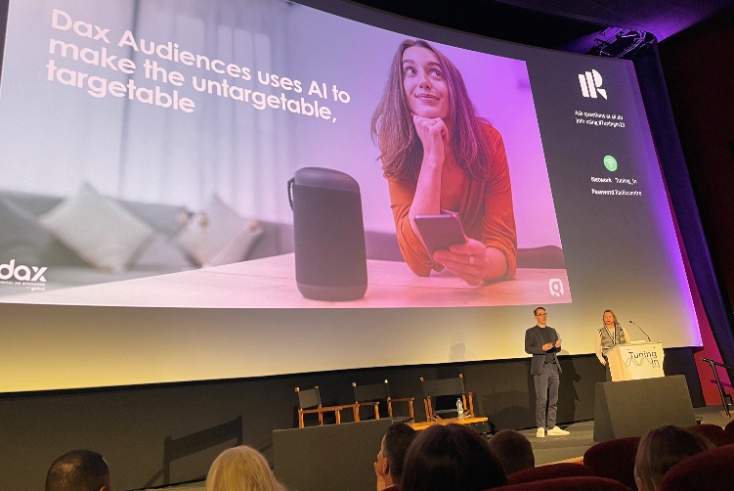Smart speaker listening and ownership is growing, but how can brands make the most of the opportunity?
At Radiocentre’s annual Tuning In conference at Picturehouse Central today, Global’s director of group strategy Mark Hatwell, and Dax (Global) strategy director Faye McDowall spoke to attendees about how they made the “untargetable audiences” on smart speakers “targetable”.
Global’s own research found Amazon Alexa devices were found in 60% of homes, with many having more than one device in different rooms. This equated to 13.8 million in total digital audio reach including music, podcasts and live radio, which is still the number one activity on these devices. They also made up, at last count, 17% of total commercial audio hours, according to Hatwell.
He emphasised that the scale of this opportunity was “a real signal of radio’s digital transformation. However, “commercially speaking, there was a problem,” he warned.
“These streams are delivering amazing numbers, but unfortunately, they do sit behind the walled gardens of those tech giants which means the devices do not share the digital identifiers that power much of the detailed digital targeting that our commercial partners need,” Hatwell explained. “That’s how they work with other channels, that’s how they need to work with audio. So we needed to find a new way to unlock this powerful targeting opportunity that did not rely on those personal identifiers.”
Global set about using AI to create “lookalike audiences” for commercial partners. Using an example of “film enthusiasts” target audience, McDowall added they could see into their consumption and habits, from streaming services they subscribe to, articles they have read, videos they have watched and listening behaviours, like if they have read about the new Marvel release, watched interviews with Barbie stars, or frequently watch Disney+.
Heart and Alexa launch joint campaign
She added: “Our AI model is able to identify the similarities in the listening patterns of the people that we do know and see, versus the non-identified eyeballs. So by what the AI model does is it looks at those similar patterns and decides that person or that listen more accurately fits with the film enthusiasts behaviour. And that all goes into the model. And this is a continuous cycle of modelling that goes on.”
Currently there are 20 AI-built smart speaker audiences available advertisers, with another 10 being built starting with the most-demanded, McDowall added.
She also said the roadmap was to move to 100% first and second party data, with “bolstering some categories where appropriate” from partners, and that these AI-build audiences were verified by Accenture.
Hatwell said: “We’re all very aware of the deprecation of third-party cookies and the impact that can have on total targetable inventory. This privacy-first approach, led by AI, also future-proofs, and supercharges total tax reach across all platforms.”
These changes have meant total targetable reach across DAX content of all types has increased by a factor of 10, Hatwell said.
Rajar Q2 2023: commercial grows share on smart speakers
Live radio still ‘best use of audio’
Matt Payton, Radiocentre CEO, made the case for live commercial radio being front of mind for advertisers in his introduction to its annual Tuning In conference.
He said: “We know that competition for listening is intensifying, with other types of audio like podcasts and music streaming, growing in popularity all the time, but for advertisers who are considering the best use of audio, it’s also worth remembering that radio represents by far the biggest portion of commercially accessible audio hours.”
Payton highlighted that commercial radio made up 84% of these hours where advertising can be bought, when looking at non-BBC podcasts, free streaming services and commercial radio.
He also stressed that while commercial radio reaches a record weekly audience of 39 million people, and has its highest ever share of listening compared to the BBC of 54.5%, according to the last Rajar figures, there are “clear risks” when it comes to reliance on third party platforms, like Amazon, with smart speaker usage on the rise.
He said that even though inclusions for radio has been included in the draft Media Bill and there are politicians and civil servants that “instinctively get” the importance of radio and this legislation, he said it would not be “straightforward” given the limited amount of Parliamentary time between now and the next election. He described getting a draft bill into legislation as “a marathon” ahead, not a sprint.
Are we in a golden age of audio? With Radiocentre CEO Matt Payton
Adwanted UK are the audio experts operating at the centre of audio trading, distribution and analytic processing. Contact us for
more information on J-ET, Audiotrack or our RAJAR data engine. To access our audio industry directory, visit
audioscape.info and to find your new job in audio visit
The Media Leader Jobs, a dedicated marketplace for media, advertising and adtech roles.




